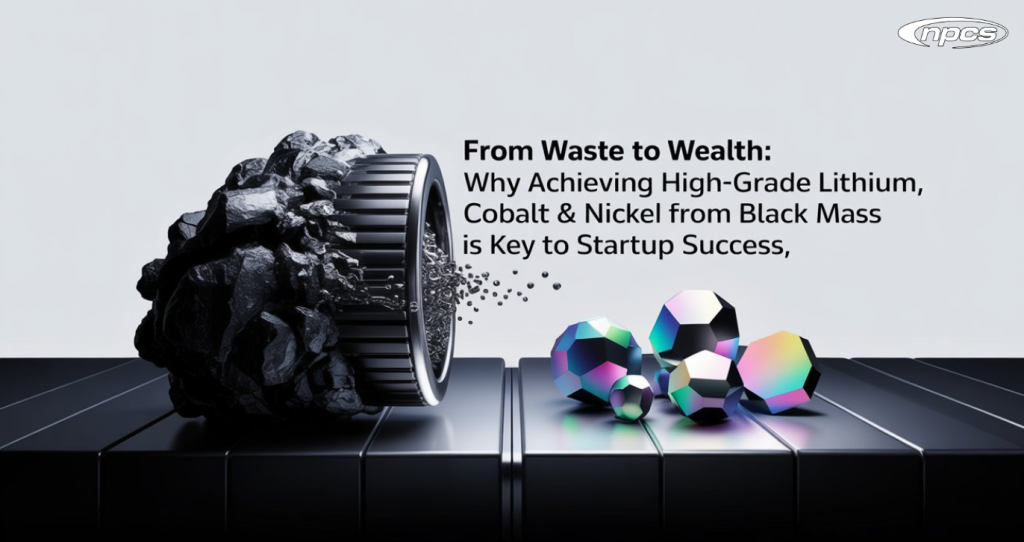In the new experiments happening in the clean energy ecosystem, Waste to Wealth is no longer just a buzzword-it’s a full-blown revolution. As EVs dominate the automotive world and battery technology takes center stage in sustainability, startups have a rather startling source to capitalize upon: Black Mass. This leftover material from spent lithium-ion batteries has fast become a strategic goldmine with high-grade lithium, cobalt, and nickel-the very materials needed for manufacturing next-generation batteries.
The Growing Trend of Waste to Wealth
The Waste to Wealth movement is grabbing attention in all sectors-from e-waste recycling to green energy. For battery recycling startups, it’s a question of more than just sustainability. It’s about generating profitable, scalable solutions. By processing black mass-a dark powdery mixture of materials from battery cathode and anode-companies stand to gain by converting waste into a precious product.
This trend is good for the environment and good for the economy. Startups pursuing this paradigm can develop methods to reduce dependence on mining, cut down manufacturing costs, and enter a market that is expanding exponentially.
What is Black Mass? A Hidden Treasure
The term black mass is assigned to the shredded and processed remains of lithium-ion batteries. It contains a rich concentration of key metals like lithium, cobalt, and nickel. Instead of letting these materials go to waste, some innovative startups are leveraging technologies to extract and refine them.
The transformation of black mass is a prime example of Waste to Wealth innovation. It’s cleaner than traditional mining and more sustainable, not to forget faster than conventional mining processes. With battery waste expected to rise exponentially all over the globe, the raw material for this enterprise is, thus, inexhaustible.
Why Lithium, Cobalt & Nickel Matter
These metals are crucial for making EV batteries:
- Lithium to give batteries their energy density.
- Cobalt provides a battery with long life and thermal stability.
- Nickel to augment energy storage and cut down its cost.
High-grade recovery of these three metals from black mass not only supports the circular economy but also complements the Waste to Wealth approach. Any startup that would perfect this extraction could deliver material to the big EV manufacturers, thus creating a very reliable and sustainable supply chain.
Challenges Faced by Startups in Metal Recovery
While the concept of Waste to Wealth is promising, actualizing it comes with some challenges:
- Technical Barriers: High purity extraction of metals needs chemical and mechanical processes, both of which have to be advanced.
- Capital Investment: Equipment and R&D are significantly upfront costs requiring investments.
- Regulatory Compliance: Adhering to some regulations will be very compulsory for a company, especially the environmental and safety regulations
The long-time gains outweigh the short struggles. If startups in this realm succeed, they will earn money while cleaning the planet.
Technologies Powering the Waste to Wealth Revolution
Recycling is at the center of this change. These techniques, hydrometallurgical, pyrometallurgical, or bioleaching, are being improved to maximize yield and purity.
These technologies are making Waste to Wealth not just an abstract concept but, practically, a reality. Further areas making possible for new possibilities to be explored include AI-based analysis, automated sorting, and green solvents.
They offer an unbeatable advantage to startups that embrace these technologies early, allowing them to provide sustainable products of the highest quality to clients.
Economic Benefits of Waste to Wealth
- Lower Material Cost: Recycled metals generally cost less than newly mined ones.
- Additional Revenue Streams: Sell metals obtained or recycling services.
- Sources of Funding: Green projects attract grants, investors, and public funds.
This, in turn, enhances the possibility and success of startups that adopt the Waste to Wealth model.
Global Demand and Market Opportunity
Global battery recycling is expected to have a market size exceeding $25 billion by 2030, with a rapid rise in electric vehicles as the main impetus. Government policies have favored this change with grants and mandates for recycling.
The race is on. Agencies that innovate now in Waste to-Wealth are going to take center stage in the clean economy of tomorrow.
Case Study: Startup Success Through Waste to Wealth
Let’s take the example of a European startup that successfully built a high-yield black mass processing facility. In just 3 years, they scaled operations, attracted millions in investment, and signed contracts with EV manufacturers.
Their secret? They focused on the Waste to Wealth model, emphasizing sustainability, tech efficiency, and scalable operations. Their story is a blueprint for startups looking to make a mark in the battery materials industry.
Final Thoughts: Waste to Wealth is the Future
As the world shifts towards electrification and sustainability, Waste to Wealth is not just a noble goal—it’s a viable business model. Startups focusing on black mass recovery have a real chance to drive change while building scalable, profitable companies.
Whether it’s through lithium extraction or cobalt recovery, startups that prioritize innovation, sustainability, and efficiency are well-positioned for long-term success.
Key Takeaways
Black mass recycling is revolutionizing battery production. Lithium, cobalt, and nickel are valuable materials essential to the EV market.
Startups can gain competitive advantages by embracing the Waste to Wealth model. Investing in this space supports both environmental and financial goals.
Some More Links
Join With Us
Niir Project Consultancy Services
Related Blogs
Start Lithium-ion Battery Recycling Business
Li-ion Battery Recycling Market Boom: Black Mass Gold Rush
Join us on YouTube

